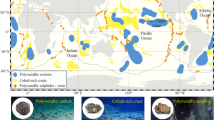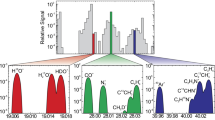Abstract
The gelatinous zooplankton of the Canada Basin were observed with a deep-diving remotely operated vehicle (ROV) during August–September, 2002. Taxa observed fell into four main groups: cnidarians, ctenophores, chaetognaths, and pelagic tunicates. We provide detailed data on the vertical distributions of many taxa from three sites which span the Canada Basin. The most common gelatinous organisms in the surface waters were the ctenophores Mertensia ovum and Bolinopsis infundibulum. These two species were found in very large numbers in the near-surface mixed layer. In the mesopelagic zone, below the transition from the Pacific water layer and the Atlantic water layer, the most common species was Sminthea arctica. Surprising numbers of the scyphomedusa Atolla tenella were found in the deep waters of the basin, along with an undescribed species of narcomedusae. The vertical distributions of the gelatinous zooplankton observed with the ROV show several trends related to the physical properties of the water and geographic location within the basin.











Similar content being viewed by others
References
Acuna JL, Deibel D, Bochdansky AB, Hatfield E (1999) In situ ingestion rates of appendicularian tunicates in the Northeast Water Polynya (NE Greenland). Mar Ecol Prog Ser 186:149–160
Ashjian CJ, Smith S, Bignami F, Hopkins T, Lane P (1997) Distribution of zooplankton in the Northeast Water Polynya during summer 1992. J Mar Syst 10:279–298
Ashjian CJ, Davis CS, Gallager SM, Alatalo P (2001) Distribution of plankton, particles, and hydrographic features across Georges Bank described using the Video Plankton Recorder. Deep-Sea Res 48:245–282
Bigelow HB (1920) Medusae and Ctenophora, vol 8. Report of the Canadian Arctic Expedition 1913–18. Southern Party 1913–1916, pp 3H–20H
Bluhm BA, MacDonald IR, Debenham C (2004) Macro- and megabenthos communities in the high Arctic Canada Basin and Northwind Ridge: initial findings. Polar Biol DOI 10.1007/s00300-004-0675-4
Brodeur RD (1998) In situ observations of the association between juvenile fishes and scyphomedusae in the Bering Sea. Mar Ecol Prog Ser 163:11–20
Brodeur RD, Mills CE, Overland JE, Walters GE, Schumacher JD (1999) Evidence for a substantial increase in gelatinous zooplankton in the Bering Sea, with possible links to climate change. Fish Oceanogr 8:296–306
Conover RJ, Huntley M (1991) Copepods in ice-covered seas: distribution, adaptations to seasonally limited food, metabolism, growth patterns and life cycle strategies in polar seas. J Mar Syst 2:1–41
Gorsky G, Flood PR, Youngbluth MJ, Picheral M, Grisoni J-M (2000) Zooplankton distribution in four western Norwegian fjords. Estuar Coast Shelf Sci 50:129–135
Graham WM, Pagès F, Hamner WM (2001) A physical context for gelatinous zooplankton aggregations: a review. Hydrobiology 451:199–212
Hamner WM, Schneider D (1986) Regularly spaced rows of medusae in the Bering Sea: role of Langmuir circulation. Limnol Oceanogr 31:171–177
Hood RR, Wang HV, Purcell JE, Houde ED, Harding LW Jr (1999) Modeling particles and pelagic organisms in Chesapeake Bay: convergent features control plankton distributions. J Geophys Res 104:1223–1243, 3289–3290
Hopcroft RR, Robison BH (1999) A new mesopelagic larvacean, Mesochordaeus erythrocephalus, sp. nov., from Monterey Bay, with description of its filtering house. J Plankton Res 21:1923–1937
Hopcroft RR, Clarke C, Nelson RJ, Raskoff KA (2004) Zooplankton communities across the Arctic’s Canada Basin: the contribution by smaller taxa. Polar Biol
Iken K, Bluhm B, Grainger R (2004) Connectivity between sea ice, pelagic and benthic food webs in the deep Canada Basin, Arctic: evidence from d13C and d15 N analysis. Polar Biol
Kosobokova K, Hirche H-J (2000) Zooplankton distribution across the Lomonosov Ridge, Arctic Ocean: species inventory, biomass and vertical structure. Deep-Sea Res I 47:2029–2060
Larson RJ, Matsumoto GI, Madin LP, Lewis LM (1992) Deep-sea benthic and benthopelagic medusae: recent observations from submersibles and a remotely operated vehicle. Bull Mar Sci 51:277–286
Lee SH, Whitledge TE (2004) Recent nutrient and primary productivity relationships in the coastal and nearshore regions of the western Arctic. Polar Biol
McLaughlin F, Shimada K, Carmack E, Ito M, Nishino S (2004) The hydrography of the deep Canada Basin, 2002. Polar Biol
Mills CE (1995) Medusae, siphonophores, and ctenophores as planktivorous predators in changing global ecosystems. ICES J Mar Sci 53:575–581
Mumm N, Auel H, Hanssen H, Hagen W, Richter C, Hirche H-J (1998) Breaking the ice: large-scale distribution of mesozooplankton after a decade of Arctic and transpolar cruises. Polar Biol 20:189–197
Pagès F (1997) The gelatinous zooplankton in the pelagic system of the Southern Ocean: a review. Ann Inst Océanogr Paris 73:139–158
Pagès F, White MG, Rodhouse PG (1996) Abundance of gelatinous carnivores in the nekton community of the Antarctic Polar Frontal Zone in summer 1994. Mar Ecol Prog Ser 41:139–147
Pugh PR (1989) Gelatinous zooplankton—the forgotten fauna. Prog Underwater Sci 14:67–78
Purcell JE (1991) A review of cnidarians and ctenophores feeding on competitors in the plankton. Hydrobiologia 216/217:335–342
Purcell JE (1997) Pelagic cnidarians and ctenophores as predators: selective predation, feeding rates and effects on prey populations. Ann Inst Oceanogr Paris 73:125–137
Purcell JE (2003) Predation on zooplankton by large jellyfish (Aurelia labiata, Cyanea capillata, Aequorea aequorea) in Prince William Sound, Alaska. Mar Ecol Prog Ser 246:137–152
Purcell JE, Arai MN (2001) Interactions of pelagic cnidarians and ctenophores with fishes: a review. Hydrobiologia 451 (Dev Hydrobiol) 155:27–44
Purcell JE, Brown ED, Stokesbury KDE, Haldorson LH, Shirley TC (2000) Aggregations of the jellyfish Aurelia labiata: abundance, distribution, association with age-0 walleye pollock, and behaviors promoting aggregation in Prince William Sound, Alaska. Mar Ecol Prog Ser 195:145–158
Purcell JE, Breitburg DL, Decker MB, Graham WM, Youngbluth MJ, Raskoff KA (2001) Pelagic cnidarians and ctenophores in low dissolved oxygen environments. In: Rabalais NN, Turner RE (eds) Coastal hypoxia: consequences for living resources and ecosystems, vol 58, pp 77–100. American Geophysical Union, Washington
Raskoff KA (2001a) The impact of El Niño events on populations of mesopelagic hydromedusae. Hydrobiologia 451:121–129
Raskoff KA (2001b) The ecology of the mesopelagic hydromedusae in Monterey Bay, California. PhD Dissertation, University of California
Raskoff KA (2002) Foraging, prey capture, and gut contents of the mesopelagic narcomedusa, Solmissus spp. (Cnidaria: Hydrozoa). Mar Biol 141:1088–1107
Robison BH (2004) Deep pelagic biology. J Exp Mar Biol Ecol 300:253–272
Robison BH, Reisenbichler KR, Sherlock RE, Silguero JMB, Chavez FP (1998) Seasonal abundance of the siphonophore, Nanomia bijuga, in Monterey Bay. Deep-Sea Res II 45:1741–1751
Schnack-Schiel SB, Mujica A (1994) The zooplankton of the Antarctic Peninsula region. In: El-Sayed SZ (d) Southern Ocean ecology: the BIOMASS perspective. University Press, Cambridge, pp 79–92
Shiga N, Takagi S, Nishiuchi K (1998) Interannual variation and vertical distribution of appendicularians in the south of St. Lawrence Island, northern Bering Sea shelf, in summer, vol 45. Memoirs of the Faculty of Fisheries, Hokkaido University, pp 48–51
Siferd TD, Conover RJ (1992) Natural history of ctenophores in the Resolute Passage area of the Canadian High Arctic with special reference to Mertensia ovum. Mar Ecol Prog Ser 86:133–144
Sirenko BI (2001) List of species of free-living invertebrates of Eurasian Arctic Seas and adjacent deep waters. Russian Academy of Sciences, St Petersburg, p 132
Smith SL, Schnack-Schiel SB (1990) Polar zooplankton. Polar oceanography, part B: chemistry, biology, and geology. Academic Press, San Diego, pp 527–598
Stepanjants SD (1989) Hydrozoa of the Eurasian Arctic Seas. In: Herman Y (ed) The Arctic Seas: climatology, oceanography, geology, and biology. Van Nostrand Reinhold, New York, pp 397–430
Stüebing D, Piepenburg D (1998) Occurrence of the benthic trachymedusa Ptychogastria polaris Allman, 1878 (Cnidaria: Hydrozoa) off Northeast Greenland and in the northern Barents Sea. Polar Biol 19:193–197
Swanberg N, Båmstedt U (1991a) The role of prey stratification in the predation pressure by the cydippid ctenophore Mertensia ovum in the Barents Sea. Hydrobiologia 216/217:343–349
Swanberg N, Båmstedt U (1991b) Ctenophora in the Arctic: the abundance, distribution, and predatory impact of the cydippid ctenophore Mertensia ovum (Fabricius) in the Barents Sea. In: Proceedings of the Pro Mare symposium on polar marine ecology 12–16 May, 1990. Polar Res 10:507–524
Thibault D, Head EJH, Wheeler PA (1999) Mesozooplankton in the Arctic Ocean in summer. Deep-Sea Res 46:1391–1415
Wheeler PA, Gosselin M, Sherr E, Thibault D, Kirchman DL, Benner R, Whitledge TE (1996) Active cycling of organic carbon in the central Arctic Ocean. Nature 380:697–699
Youngbluth MJ (1984) Manned submersibles and sophisticated instrumentation: tools for oceanographic research. In: Proceedings of SUBTECH 1983 symposium. Society of Underwater Technology, London, pp 335–344
Youngbluth MJ, Båmstedt U (2001) Distribution, abundance, behavior and metabolism of Periphylla periphylla, a mesopelagic coronate medusa in a Norwegian fjord. Hydrobiologia 451:321–333
Youngbluth MJ, Bailey TG, Jacoby CA (1990) Biological explorations in the mid-ocean realm: Food webs, particle flux, and technical advancements. In: Lin YC, Shida KK (eds) Man in the Sea, vol 2. Best Publishing, San Pedro, pp 191–208
Acknowledgements
We would like to thank F. McLaughlin, K. Crane, M. Youngbluth, M. Vecchione, M. Cole, E. Kristof, P. Nicklen, C. Nicholson, J. Potter, J. Steinberg Holland, K. Shirley, A. Raskoff, and G. Matsumoto. The cruise was a collaboration of many organizations, including the National Oceanic and Atmospheric Association (NOAA), the Canadian Department of Fisheries and Oceans, and the National Science Foundation. NOAA’s office of Ocean Exploration sponsored the ROV work.
Author information
Authors and Affiliations
Corresponding author
Rights and permissions
About this article
Cite this article
Raskoff, K.A., Purcell, J.E. & Hopcroft, R.R. Gelatinous zooplankton of the Arctic Ocean: in situ observations under the ice. Polar Biol 28, 207–217 (2005). https://doi.org/10.1007/s00300-004-0677-2
Received:
Revised:
Accepted:
Published:
Issue Date:
DOI: https://doi.org/10.1007/s00300-004-0677-2




